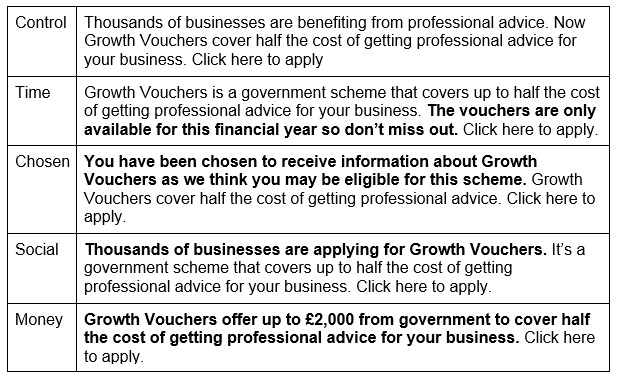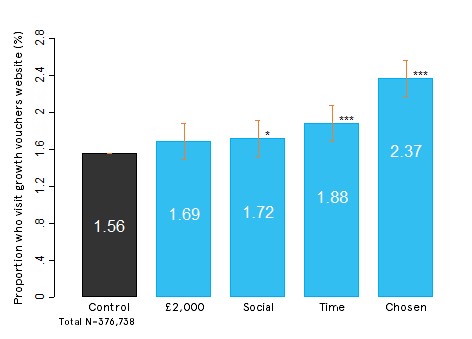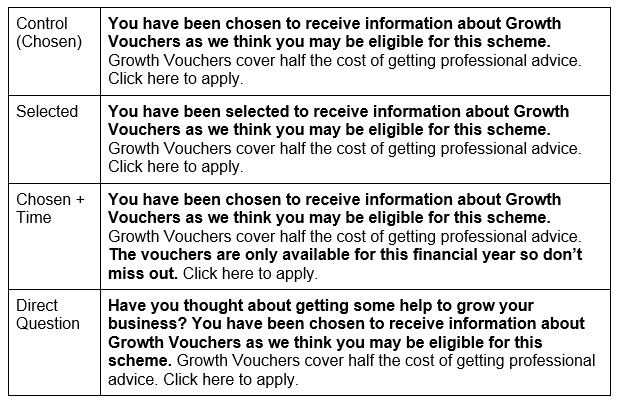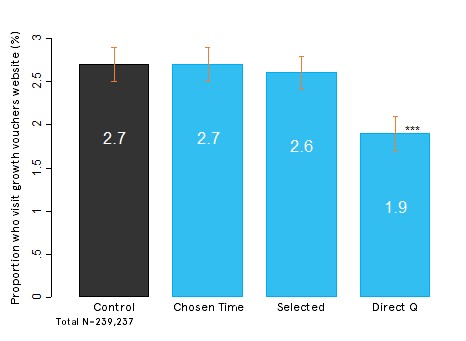In 2013 and 2014 BIT worked with the Department for Business, Innovation and Skills to design, launch and run the Growth Vouchers programme. After the scheme had launched the number of applications was lower than hoped. This is not an uncommon occurrence with Government schemes – lots of time and thought goes into devising and launching the schemes but time and again take up is lower than expected (or desired) because people just don’t know the programmes exist. Marketing can help raise awareness but it is often very expensive and difficult to quantify the impact of different adverts/channels.
Government already has contact with many of the people their programmes are designed to help so an obvious approach seemed to be to use these existing relationships to tell people about schemes they might be interested in. HMRC regularly sends out information about tax to businesses so we worked with them to prompt and inform small businesses about various schemes they might be interested in. The first scheme to be promoted this way was Growth Vouchers. Being the Behavioural Insights Team we couldn’t pass up an opportunity to run a trial to test which types of message were most appealing.
The trial involved sending emails to over 600,000 individual small and medium enterprises (SMEs) who had registered with HMRC to find out more about tax and then measuring how many firms clicked to apply for a Growth Voucher. The content of all the emails was identical apart from the opening paragraph which varied depending on the trial arm. The greeting, and sign off of the email were set by HMRC’s system, and no pictures were included.
For technical reasons we were limited to having five different emails being sent out at one time so we ran the trial in two stages. In the first stage we had a control group plus 4 treatment groups which tested different messages based on the behavioural literature. The different messages we tested are were:
The graph below shows the results – all three treatments led to a significant increase in click through rates with ‘chosen’ being the most effective.
Figure 1: Proportion of recipients clicking to apply for the Growth Vouchers scheme, Stage 1
* p < 0.05, ** p < 0.01, *** p < 0.001
True to our mantra of Test, Learn, Adapt we used the best performing email from the first stage as the control group in the second stage. This time we tested three further variations, two of which were combinations of approaches that had been shown to be effective in different contexts (‘chosen+time’ and ‘direct question’).
The results from this trial are shown in the graph below. This time we did not find any of the messages significantly increased click-through rates; in fact ‘DirectQ’, led to significantly fewer people clicking through to the Growth Vouchers website.
Figure 2: Proportion of recipients clicking to apply for the Growth Vouchers scheme, Stage 2
* p < 0.05, ** p < 0.01, *** p < 0.001
In conclusion, we found that telling firms they had been ‘chosen’ to receive information (personalisation) was the most effective way to encourage them to apply for the Growth Vouchers scheme. Using the word ‘selected’ performed almost identically and was deemed to be more appropriate language for HMRC to use in their communications. Overall the trial led to an extra 9,000 applications for the Growth Vouchers programme (more than any other single source); all generated using a communication channel that was free. Since this first trial, HMRC channels have been used to promote a wide range of schemes including Broadband Vouchers and apprenticeships which is a great example of Government departments working well together to promote schemes in a more coherent way.
To learn more about how to apply behavioural insights to communications join us at BX2015 in September to hear Steven Pinker and Robert Cialdini, two of the most highly acclaimed figures in the science of communication and influence talk about the science of style and persuasion in our session entitled “Words that matter”.




